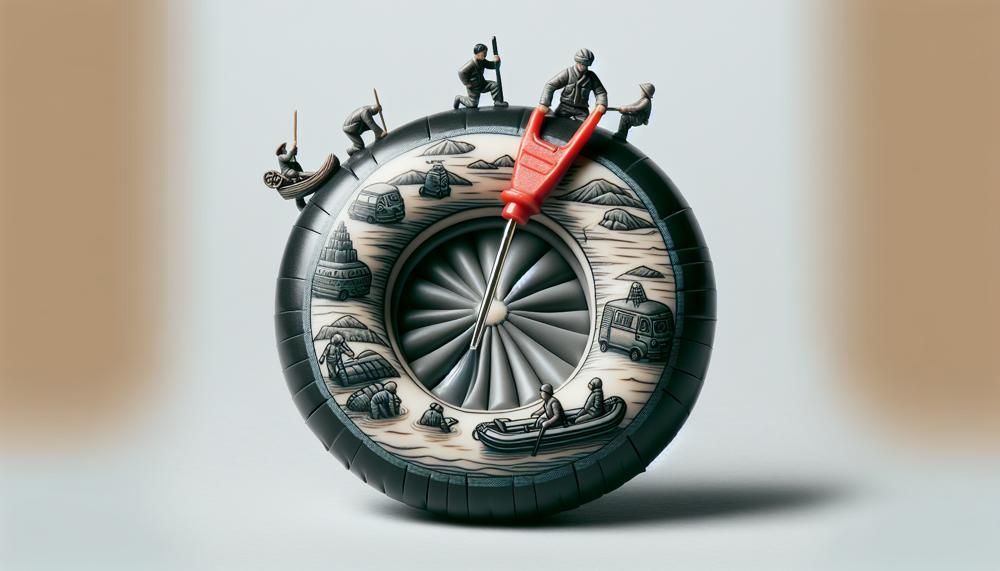Have you ever been lounging on your inflatable pool or air mattress, only to hear a dreaded hissing sound and feel it slowly deflating beneath you? It’s a frustrating experience that can quickly put a damper on your summer fun.
But before you toss out your beloved inflatables and splurge on new ones, why not try fixing them yourself? With a little know-how and the right tools, you can easily locate and repair leaks or punctures in any inflatable object.
In this blog post, we’ll walk you through the process step by step, so you can get back to enjoying your inflatables without worry. From identifying the type of leak to choosing the best repair method, we’ve got you covered.
So grab your tools and let’s dive into the world of inflatable maintenance. Here’s what we’ll cover:
- Understanding different types of leaks and punctures
- Essential tools for successful repairs
- A detailed guide for locating and fixing leaks
- Pro tips for preventing future leaks
Don’t let a tiny hole deflate your summer fun – let’s learn how to fix it together.
Repairng Inflatable Kayaks – Key Takeaways
Contents
Repairing an inflatable kayak can be a daunting task, but with the right approach, it can be a simple and seamless process. Below are the key steps you need to take when fixing a leak or puncture in your inflatable kayak:
| Step 1: | Identify the leak/puncture | – Inflate the kayak fully to reveal any potential leaks or punctures.– Use a soapy water solution and a sponge to check for bubbles, which is a clear indication of a leak.– Listen carefully for hissing sounds, which may indicate a puncture that requires immediate attention.– Inspect the kayak for any visible damage that may need to be addressed. |
| Step 2: | Prepare the repair kit | – It is essential to have a repair kit on hand before your trip to avoid any delays in fixing any potential leaks or punctures.– A basic repair kit should include a PVC patch, adhesive/glue, sandpaper, and cleaning solvent.– Optional components such as inflatable repair tape, heat gun or hairdryer can also come in handy during the repair process. |
| Step 3: | Clean and dry the damaged area | – Before proceeding with the repair, it is crucial to clean the damaged area thoroughly. Use a cleaning solvent to remove any dirt or debris that may interfere with the repair process.– Allow the area to dry completely before moving on to the next step. This ensures that the adhesive/glue used in the following step bonds properly with the surface. |
| Step 4: | Sand down the damaged area | – To achieve a smooth and seamless repair, gently sand the damaged area in a circular motion. This will remove any rough edges and create a clean surface for the adhesive/glue to bond with. |
| Step 5: | Apply adhesive/glue | – Follow the manufacturer’s instructions carefully when applying the adhesive/glue.– Use a brush or spatula to spread the adhesive/glue evenly over the damaged area.– Apply enough pressure to ensure a strong bond between the surface and the patch. |
| Step 6: | Attach the patch | – Carefully place the patch over the damaged area, starting from one end and pressing down firmly to remove any air bubbles that may have formed.– Use a roller or any smooth object to ensure a secure bond between the surface and the patch. |
Tools and Materials You’ll Need
To effectively locate and repair a leak or puncture in an inflatable, you’ll need the following essential tools and materials:
- Inflatable patch kit
- Air pump
- Marking tool
- Water and soap solution
- Cleaning supplies
- Protective gloves
- Repair manual/instructions
These items are crucial for successfully identifying and fixing the issue, as well as ensuring a smooth and seamless repair. Without them, you may struggle to properly locate the leak or puncture, prepare the area for repair, and accurately apply a patch.

It’s important to have an inflatable patch kit on hand, as it will contain all the necessary materials for repairing a leak or puncture. An air pump is also necessary to inflate the inflatable and identify where the air is escaping from. A marking tool, such as a pen or chalk, can help you easily mark the location of the leak.
Additionally, you’ll need a water and soap solution to identify any small bubbles that may indicate a leak. Cleaning supplies are also important for preparing the area before applying the patch. Protective gloves are recommended to ensure your hands are protected during the repair process.
Lastly, having a repair manual or instructions will guide you through the process step-by-step and ensure you properly apply the patch for a successful fix.
How To Find A Leak: A Step-By-Step Guide
Here, we will walk you through the process of identifying and repairing leaks to ensure that your kayak stays in top condition for many adventures to come.
- Step 1: The first step is to inflate your kayak to the recommended PSI and inspect it carefully on an elevated surface, or by thoroughly examining both the top and bottom surfaces.
- Step 2: Next, try the “soapy water” method. Simply mix soap and water in a spray bottle or bucket, apply it to the surface of your kayak, and watch for bubbles. These bubbles will indicate the presence of a leak.
- Step 3: Once you have identified a leak, make sure to dry the area completely and mark it with a grease pen or marker.
- Step 4: Deflate your kayak on a level surface and prepare the surface for patching. You can do this by cutting out a circle-shaped patch using scissors or a box cutter.
- Step 5: Apply adhesive to both the patch and the hull, wait for it to become tacky, then press it firmly onto the hull.
- Step 6: Allow some time for the adhesive to cure (usually between 2-24 hours) before reinflating your kayak and checking for any remaining leaks.
- Step 7: To prevent future leaks, make sure to properly store your kayak away from extreme temperatures and direct sunlight. Avoid dragging it over rough terrain or areas with lots of litter. Regularly inspect your kayak for damage, clean it with mild soap after each use, and use 303 Marine Protectant on valves.
- Step 8: If your kayak has extensive damages or large tears that affect its structural integrity, it’s best to seek professional repair services.
- Step 9: While duct tape can be a temporary solution until you reach shore, it should not be relied upon as a permanent fix.
By following these steps, you can effectively locate and repair any leaks or punctures in your inflatable kayak.
How To Patch Repair An Inflatable Kayak: A Step-By-Step Guide
When it comes to patching and repairing a leak or puncture in your inflatable kayak, there are a few key materials and tools that you will need to have on hand to ensure a successful fix. These include a patch made of PVC or Hypalon material, scissors or a knife for cutting, adhesive specifically designed for inflatable materials (such as PVC or Hypalon glue, contact cement, or marine adhesive), and sandpaper or a rough sponge for preparing the surface.
While these are the essential materials and tools needed for patching an inflatable kayak, it’s also recommended to have a repair kit specifically designed for this purpose.
This will ensure that you have all the necessary items in one convenient package, making the repair process even easier.
It’s important to invest in high-quality materials and tools when repairing your inflatable kayak to ensure lasting results.
Properly storing and handling your kayak, regularly maintaining and cleaning it, and avoiding exposure to extreme temperatures and rough terrain can also help prevent leaks from occurring in the first place.
How Can I Prevent Leaks In My Inflatable Kayak?
There are multiple strategies for preventing leaks in your inflatable kayak, including properly inflating the kayak, avoiding sharp objects, storing it correctly, using protective gear, regularly inspecting it, avoiding overloading it, being cautious when inflating, and having a repair kit with you.
Let’s delve deeper into these tips and explore how they can assist you in keeping your inflatable kayak in excellent condition.
| Action | Description |
| Ensure proper inflation | Inflate your kayak to the recommended pressure to avoid unnecessary strain on the seams and material. |
| Avoid sharp hazards | Steer clear of areas with potential dangers and be mindful of sharp objects such as rocks and fishing hooks. |
| Store it correctly | Find a dry and cool place to store your kayak, away from any potential puncture hazards. |
| Use protective gear | Consider using a spray skirt or keel guard for extra protection when kayaking in rough waters or hazardous areas. |
| Regularly inspect for damage | Frequently check for signs of wear and tear and address any issues before they become bigger problems. |
| Avoid overloading | Know your kayak’s weight limit and avoid exceeding it to prevent unnecessary strain on the material. |
| Be gentle when inflating | Use gentle pressure when inflating your kayak to avoid putting stress on the seams. |
| Carry a repair kit | Always have a repair kit with you in case of accidents or punctures and fix any leaks promptly. |
To ensure your inflatable kayak stays leak-free, proper maintenance is crucial. Remember to inflate your kayak to the recommended pressure, avoid sharp hazards, store it in a safe place, use protective gear, regularly inspect for damage, avoid overloading it, be gentle when inflating, and have a repair kit on hand.
These simple tips will help keep your inflatable kayak in top condition and provide you with many enjoyable kayaking adventures.
Tips for Preventing Leaks and Punctures in Inflatables
- Handle inflatables with care.
- Avoid dragging or scraping inflatables on rough surfaces.
- Store inflatables in a cool, dry place.
- Don’t overinflate inflatables.
Conclusion
In conclusion, the process of finding and repairing a leak or puncture in your inflatable may seem daunting at first, but with the right approach and tools, it can be a breeze. By understanding the different types of leaks and having essential tools on hand, you can easily locate and fix any issues that may arise.
Following a step-by-step guide for repair and taking preventive measures to avoid future leaks will ensure your inflatable stays in top shape for all your summer adventures.
Remember to properly inflate your kayak, store it correctly, use protective gear, regularly inspect for damage, avoid overloading it, and be gentle when inflating. It’s also important to have a repair kit on hand at all times.
Don’t let a tiny hole deflate your summer fun – with these tips in mind, you can confidently handle any leak or puncture that comes your way.







